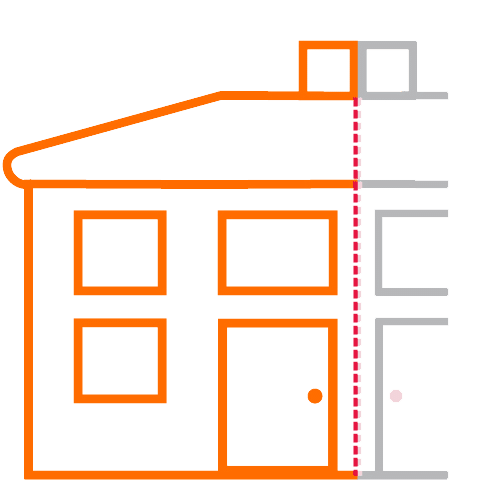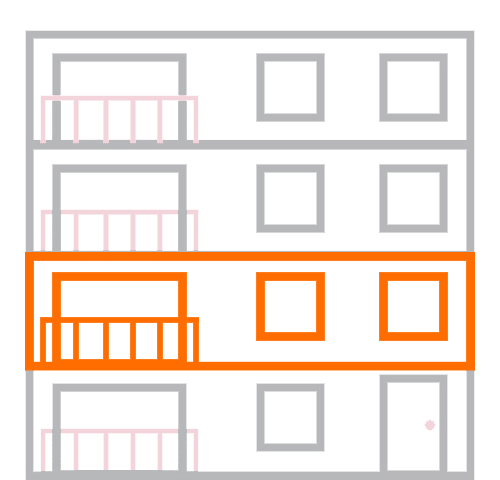Thinking about internal wall insulation? It's a great choice for boosting your home's energy efficiency by up to 30%, lowering energy bills, and enhancing comfort with consistent temperatures year-round. You'll even get soundproofing benefits and a healthier environment by reducing condensation and mold risk. Ideal for older homes where external insulation isn't an option, this insulation can also increase your property's value. Choosing the right material, like rigid foam or mineral wool, and installing it precisely is essential for success. Curious about the installation steps, potential savings, or best practices? There's more to uncover about these aspects.
Understanding Internal Wall Insulation
Table of Contents
ToggleInternal wall insulation is a practical solution for enhancing energy efficiency in your home. It involves adding a layer of insulating material to the inside walls of your house. By doing so, you create a barrier that helps to prevent heat from escaping, keeping your home warmer in the winter and cooler in the summer.
It's particularly useful if you live in an older property where external insulation mightn't be an option, or if you want to preserve the exterior appearance of your home.
To get started with internal wall insulation, you'll need to choose the right materials. Common options include rigid foam boards, mineral wool, or more advanced materials like aerogel. Each material has different properties, such as thermal resistance, cost, and ease of installation.
You should consider these factors carefully to find the best fit for your specific needs.
When installing internal wall insulation, precision is key. You'll need to verify that the materials are cut to fit perfectly and that they're securely attached to the walls. This might involve fixing them with adhesive or using mechanical fasteners.
With careful planning and execution, internal wall insulation can greatly improve your home's comfort and efficiency.
Benefits of Internal Wall Insulation
A multitude of benefits comes with installing internal wall insulation in your home.
First, it markedly enhances your property's energy efficiency. By reducing heat loss, you'll keep your home warmer in winter and cooler in summer without relying heavily on your heating or cooling systems. This translates to lower energy bills, saving you money in the long run.
You'll also enjoy improved comfort. Insulating your internal walls helps maintain a consistent temperature throughout your home, eliminating those pesky cold spots.
Plus, it acts as a sound barrier, reducing noise from outside and between rooms, making your home a more peaceful place to live.
Additionally, internal wall insulation contributes to a healthier indoor environment. It helps prevent condensation and dampness, reducing the risk of mold growth, which is beneficial for your health.
You'll find your home's air quality improves, creating a better living environment for you and your family.
Lastly, if you're looking to increase your property's value, internal wall insulation is a smart investment. Potential buyers are often attracted to energy-efficient homes, and having insulation already installed can make your property more appealing on the market.
Types of Insulation Materials
When considering internal wall insulation, you'll find several types of materials available, each with unique benefits. Choosing the right one depends on your specific needs, budget, and the characteristics of your home.
First, there's mineral wool, a popular choice because it's fire-resistant and offers excellent soundproofing. It's made from either rock wool or slag wool and comes in rolls or batts, making it easy to handle.
Next, you might consider rigid foam boards. These are highly effective at reducing heat loss and have a high insulation value for their thickness. They're lightweight and can be easily cut to fit any space.
Another option is spray foam insulation. This material expands when applied, sealing even the smallest gaps and providing a continuous barrier against air and moisture. It's known for its superior performance but can be more expensive.
Lastly, natural fiber options like sheep's wool or cotton provide eco-friendly alternatives. They're renewable and biodegradable, which might appeal to you if you're environmentally conscious.
- Mineral Wool: Fire-resistant, soundproofing, easy to handle.
- Rigid Foam Boards: High insulation value, lightweight.
- Spray Foam: Expands to seal gaps, continuous barrier.
- Natural Fibers: Eco-friendly, renewable, biodegradable.
Installation Process Overview
Choosing the right insulation material is just the beginning; understanding the installation process is equally important. Start by gathering all necessary tools and materials, including the insulation panels, adhesive, and any safety gear. Make certain your work area is clean and free of obstructions to facilitate a smooth installation.
Begin by measuring the wall dimensions accurately. Cut the insulation panels to size, guaranteeing they fit snugly without gaps. Apply adhesive to the back of each panel, following the manufacturer's instructions carefully. You want a secure bond, so don't skimp on this step.
Next, position the panel against the wall, pressing firmly to ensure good contact. Use a level to make sure it's perfectly aligned. Continue this process, working from one end of the wall to the other, ensuring each panel is tightly butted against the next to minimize thermal bridging.
Lastly, seal any joints or gaps with appropriate sealant or tape to enhance thermal efficiency. Remember, a well-executed installation not only improves energy efficiency but also prolongs the lifespan of your insulation.
Take your time, and don't rush—precision is key for ideal results.
Assessing Wall Suitability
Evaluating the suitability of your walls is a significant first step in any insulation project. You need to make certain that your walls can effectively support internal insulation and meet the necessary criteria.
Start by checking the structural integrity of your walls. They should be free from significant cracks or moisture issues that could compromise the insulation. If your walls have any signs of dampness, it's essential to address these issues before proceeding.
Next, consider the type of walls you have. Solid brick, concrete, or stone walls are usually suitable for internal insulation, but you must verify their condition. In older buildings, the materials might've deteriorated, so a detailed assessment is necessary.
Keep an eye out for:
- Moisture Levels: Excess moisture can lead to mold growth, reducing insulation effectiveness.
- Wall Surface: Smooth, clean surfaces are ideal for insulation attachment.
- Ventilation: Make certain adequate ventilation to prevent condensation issues post-insulation.
- Existing Fixtures: Be mindful of any obstructions like radiators or electrical fittings.
Once you've assessed these factors, you'll have a clearer picture of whether your walls are ready for insulation.
Cost Considerations and Savings
To guarantee you're making a sound investment, it's important to take into account both the costs and the potential savings of internal wall insulation.
First, consider the initial expense. Installation can range from $40 to $60 per square meter, depending on the materials and labor costs in your area. While this might seem steep, remember that it's a one-time investment that can greatly enhance your home's energy efficiency.
Next, focus on the long-term savings. By reducing heat loss, internal wall insulation can lower your energy bills by up to 30%. This means that over time, the insulation pays for itself. Depending on your property's size and your local climate, the payback period could be as short as five years.
Additionally, you might be eligible for government grants or incentives aimed at improving energy efficiency. These programs can ease the financial burden and make the project more affordable.
Common Challenges and Solutions
Initiating an internal wall insulation project can bring challenges, but understanding them upfront helps in finding effective solutions.
One common issue is dealing with moisture. If moisture isn't managed, it can lead to mold and structural damage. To solve this, guarantee proper ventilation and use moisture-resistant materials.
Another challenge is losing space inside your room. Insulation can reduce your living area, especially in smaller spaces. Consider thinner insulation materials that still provide effective thermal resistance.
Cost overruns are another concern. Unexpected expenses can arise if the project scope changes or if materials aren't estimated accurately. To avoid this, plan meticulously and set aside a contingency budget.
Finally, dealing with electrical outlets and fixtures can be tricky. Insulation can obstruct access, making maintenance difficult. To tackle this, reposition outlets or use extension boxes.
Here are four common challenges and their solutions:
- Moisture management: Guarantee proper ventilation and use moisture-resistant materials.
- Space loss: Choose thinner, high-performance insulation materials.
- Cost overruns: Plan meticulously and maintain a contingency budget.
- Electrical access: Reposition outlets or use extension boxes for better access.
Best Practices for Insulation
Implementing best practices in internal wall insulation guarantees you maximize energy efficiency and comfort in your home. First, choose the right type of insulation material. Materials like rigid foam boards, mineral wool, or even eco-friendly options like sheep wool each have unique benefits. You'll want to take into account the thermal resistance (R-value) and the specific needs of your home.
Next, focus on proper installation. Confirm the insulation fits snugly between studs without gaps or compression, as this can drastically reduce its effectiveness. Remember, a professional installation can often guarantee better results.
Here's a quick reference table of materials and their benefits:
| Material | R-Value (per inch) | Benefits |
|---|---|---|
| Rigid Foam Board | 3.5 – 6.5 | High R-value, moisture resistant |
| Mineral Wool | 3.0 – 3.3 | Fire resistant, soundproofing |
| Sheep Wool | 3.5 – 3.8 | Eco-friendly, moisture control |
Role in the Great British Insulation Scheme
The Great British Insulation Scheme aims to improve energy efficiency across the UK, and internal wall insulation plays an essential role in this initiative.
By focusing on reducing heat loss within homes, you can save on energy bills and contribute to a more sustainable future. Internal wall insulation helps maintain a comfortable indoor temperature and reduces the strain on your heating system.
When you consider internal wall insulation, you're looking at several benefits:
- Energy Savings: You'll notice a reduction in your energy consumption, leading to lower utility bills and a smaller carbon footprint.
- Improved Comfort: Insulated walls help maintain a consistent indoor climate, keeping your home warmer in the winter and cooler in the summer.
- Reduced Moisture: Insulation acts as a barrier to moisture, reducing the risk of dampness and mold, which can affect both your health and your home's structure.
- Enhanced Soundproofing: With added insulation, you'll experience less noise from outside, creating a quieter, more peaceful living environment.





